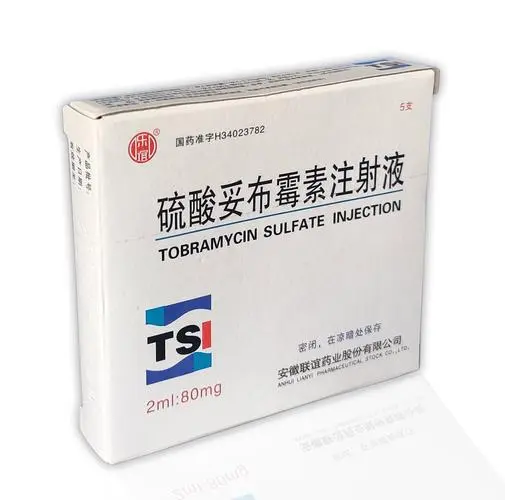Tobramycin Sulfate Injection
Effects and efficacy:
Applicable to neonatal sepsis, septicemia, central nervous system infection (including meningitis), urogenital system infection, lung infection, biliary tract infection, abdominal infection (including peritonitis), bone infection, burn infection, skin and soft tissue infection, acute and chronic otitis media, respiratory tract infection, subacute bacterial endocarditis, etc. caused by Pseudomonas aeruginosa, Proteus, Escherichia coli, Klebsiella, Enterobacter, etc. When used for Pseudomonas aeruginosa meningitis or ventriculitis, it can be administered by intrathecal injection; when used for bronchial and lung infections, it can be aerosolized and inhaled as an auxiliary treatment. Ocular preparations are used for bacterial infections of the eye such as conjunctivitis and keratitis, especially infections with Gram-negative bacilli resistant to gentamicin, such as severe Pseudomonas aeruginosa infections.
Usage and Dosage:
Adults are usually injected intramuscularly or intravenously, 1~1.7mg/kg per body weight, once every 8 hours, and the course of treatment is 7~14 days. For patients with critical infection, the dose can be increased to 8 mg/kg per day, divided into several intravenous drips, but the dose should be reduced as soon as possible after the condition improves. The common dose for children is intramuscular injection or intravenous drip, according to body weight, 2 mg/kg for those born 0-7 days, once every 12 hours; 2 mg/kg for infants and children, once every 8 hours. For those with Ccr <70 ml/min, the maintenance dose should be adjusted according to the measured creatinine clearance. The injection of this product must be fully diluted before intravenous drip. The single dose can be added to 50-200 ml of 5% glucose injection or 0.9% sodium chloride injection to dilute it into a solution with a concentration of 1 mg/ml (0.1%), and infused within 30-60 minutes (the drip time must not be less than 20 minutes). The amount of diluted liquid should be reduced accordingly when used in children. The eye drops of this product can be dripped into the eyelids, 1-2 drops/time, 3 times/day. Mild and moderate eye infections can be treated with eye ointment, 2-3 times a day, with about 1.5 cm of ointment applied to the affected eye at a time, and the amount can be reduced after the condition is relieved; eye drops can be used together with eye ointment, that is, eye drops are used during the day and eye ointment is used at night. Foreign data reported that this product can be used for aerosol treatment of cystic fibrosis and Pseudomonas aeruginosa infection. The method is to dissolve 600 mg of this product in 30 ml of 0.45% sodium chloride solution, inhale 3 times a day, and use for 4-8 weeks.
Adverse reactions:
Metabolic/endocrine system serum calcium decreases, serum magnesium decreases, serum sodium decreases, serum potassium decreases, weight decreases, and blood sugar increases. Respiratory system: dyspnea, voice change, increased cough, pharyngitis, increased sputum, discolored sputum, rhinitis, lung disease, decreased lung function, hemoptysis, asthma, pronasal protrusion, epistaxis, lower respiratory tract infection, hyperventilation, laryngitis, expectorant cough, cough, oropharyngeal pain, throat pain, dysphonia, nasal congestion, wheezing, chest tightness, laryngeal irritation, upper respiratory tract infection, decreased FEV, bronchospasm. There are also reports of aphonia after marketing. Musculoskeletal system: back pain and myalgia. Systemic administration combined with intrathecal injection may cause leg cramps and whole body spasms. Urogenital system: hematuria and significant decrease in urination frequency. Decreased urine volume, proteinuria, casts, increased blood urea nitrogen, increased blood creatinine, decreased creatinine clearance, and increased non-protein nitrogen. Immune system: Allergic reactions have been reported after marketing. Nervous system: unsteady gait, dizziness, drowsiness, dizziness, peripheral nerve effects (numbness, skin tingling, muscle tingling, convulsions), headache, and disorientation. Mental confusion. Liver: Increased serum aminotransferase, lactate dehydrogenase, and bilirubin. Gastrointestinal: Loss of appetite, extreme thirst, nausea, vomiting, diarrhea, anorexia, abdominal pain, and taste disturbance. Blood: Anemia, granulocytopenia, thrombocytopenia, leukocytopenia, leukocytosis, and eosinophilia. Skin: Rash, itching, urticaria, and exfoliative dermatitis. Ocular administration may cause itching and redness of the eyelids and conjunctival erythema. Ear: Hearing loss, tinnitus, fullness in the ears, hearing loss, and ear pain. Others: Weakness, fever, injection site reactions (pain, irritation symptoms), chest pain (including musculoskeletal chest pain), pain, and discomfort.
Drug contraindications:
Allergic reaction to this product is prohibited. It is prohibited during pregnancy. It should be used with caution during lactation. It should be used with caution in children. It should be used with caution in patients with liver function impairment.
Share:
Products
Our offers
Health Classification
Let us work together to protect precious health































